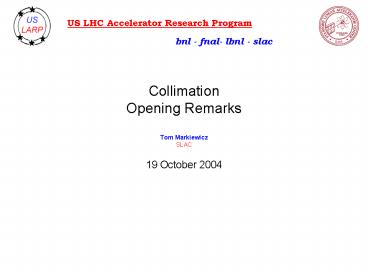Collimation Opening Remarks Tom Markiewicz SLAC - PowerPoint PPT Presentation
1 / 13
Title:
Collimation Opening Remarks Tom Markiewicz SLAC
Description:
Institutions involved in LHC Collimation. CERN, SLAC, FNAL, BNL ... External review of collimation project, June 2004 ... Collimation Opening Remarks - T. ... – PowerPoint PPT presentation
Number of Views:29
Avg rating:3.0/5.0
Title: Collimation Opening Remarks Tom Markiewicz SLAC
1
CollimationOpening RemarksTom MarkiewiczSLAC
US LHC Accelerator Research Program
bnl - fnal- lbnl - slac
- 19 October 2004
2
Meeting Goals
- Institutions involved in LHC Collimation
- CERN, SLAC, FNAL, BNL
- Agreement on how collaborating institutions will
work together to the best interests of the LHC - Who does what, by when?
- Improved methods of communication
- 1-1 email, phone
- Meetings phone, video, VRVS, physical
- Progress Reports /or Statement of Plans
- Informal Discussions with all experts present
3
Agenda
4
Milestones Since February 2004 LARP Meeting
- CERN
- External review of collimation project, June 2004
- Manufacture, installation and beam test of
prototypes - Improved energy deposition codes results
- BNL
- Installation of SixTrack / CollTrack package
- Interim Meetings
- May 2004 LARP Collimator Review at BNL
- Phased approach for Phase II
- June 2004 LAPAC at Fermilab
- Blesses project (I think)
5
Reminder of the Phase II Issue
- Primary Collimators are 20cm Carbon
- Phase I secondary collimators are 1.0m Carbon
- Survive accident (asynchronous beam abort) eat 8
bunches - Adequate system inefficiency (11E-4) and
impedance for beginning operation - 7 kW cooling can handle mandated 90kW (1 hr. beam
lifetime) load - Mechanical tolerances maintained during 450 kW
(12 min beam lifetime) excursions lasting lt 10
sec - Phase II secondary collimators
- Presumably metal for low impedance
- WILL be damaged in accident, but SLACs
rotating geometry can provide new surface
without collimator removal - Presumably will absorb more of beam
- Is required DC cooling consistent with rotating
design and required tolerances? - How do Phase II secondary collimator parameters
affect system inefficiency? - What is their role as absorbers? Absorber system
currently not designed
6
Two Possible Approaches Considered
- Engineer best collimator consistent with SLAC
technology - Or
- Delay start of engineering until requirements
better understood - Early calculations and MISCONCEPTIONS having to
do with fault scenarios led us to choose second
path - Bureaucratic Plan
- January 2005 LHC Review in Chamonix
- Formal status report to CERN
- April 2005 Go/No-Go Decision for SLAC to
prototype this collimator - If GO, hire postdoc engineer to cement what
is currently donated services from SLAC ILC
group
7
SLAC Progress Since February LARP Meeting
- Independent FLUKA analysis of 7 TeV protons in
SECONDARY collimator jaws, varying Z and L - Adoption and benchmarking of CERN FLUKA input
file describing IR7 - Basis of June Review
- FLUKA energy deposition studies of SECONDARY
collimators for protons lost on PRIMARY 20cm
collimator varying Z, L120cm - ANSYS studies of MAXIMUM JAW TEMPERATURE
MAXIMUM COOLING WATER TEMPERATURE for specified
fault scenarios for Phase II secondary
collimators - 2d at shower max for 90kW, 1 hr. beam lifetime
specification - Time dependent calculations for 10sec. excursions
to 450kW, 12min beam lifetimes - 3d calculations
- Installation and benchmarking of SixTrack and
preliminary new results for particle loss and
system inefficiency for relevant Phase II
configurations
8
FLUKA Input File
9
Heating of Phase I Graphite Secondary
CollimatorsLoss Map1, 450kW Total Loss Rate,
Jaws at 10s
Engineer Graphite TCS as 7kW device for 90kW DC
loss(730/5margin) Handle 30kW for 10 sec as
transient
10
Heating of 1.2m Cu Secondary Collimators Phase I
Carbon design In-Line with Same Aperture
14kW
130kW
5kW
30kW
SLAC calculations agrees with CERNs to 5 for
the two cases presented
Simulation is for 4E11 p/s lost on TCPV
11
Initial Design Paradigm
Replace C Phase I SC with Cu so than Collimation
System Efficiency is the identical but
Collimation System Impedance is Improved to allow
Design Parameters
11 x 10-4
2 x 10-4
AssmannMay 04
28
44
12
SLAC TEAM
- Lew Keller Energy deposition - FLUKA
- Eric Doyle Engineering ANSYS baseline
engineering - Yunhai Cai SLAC ARDA Tracking codes
- Tom Markiewicz Synthesizer
- Tor Raubenheimer New ILC Group Leader
Supporter - Andrei Seryi Will help with system design
tweaks eventually - Josef Frisch Will help with conceptual design
once problem better defined
13
Plans
- Conclusions of current studies will be presented
in parallel session on Wednesday and summarized
in Thursday plenary session. - Non-bureaucratic Work Plan for immediate future
- Upgrade FLUKA model to detailed and extensive
system developed over last year by CERN put in
use July 2004 - Fix Z, L, system inefficiency and loss map via
tracking studies at SLAC - Zero-th order conceptual design for cooling flow
and mechanical support backed by ANSYS for heat
removal distortion































